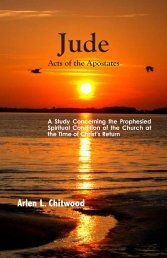Signs in John's Gospel - The Lamp Broadcast
Signs in John's Gospel - The Lamp Broadcast
Signs in John's Gospel - The Lamp Broadcast
Create successful ePaper yourself
Turn your PDF publications into a flip-book with our unique Google optimized e-Paper software.
198 SIGNS IN JOHN’S GOSPEL<br />
And His resurrection body was unlike any type body which<br />
had heretofore existed <strong>in</strong> the human realm. Christ, at the time<br />
of and follow<strong>in</strong>g His resurrection, possessed a body capable of<br />
movement from one po<strong>in</strong>t to another at will. He could appear<br />
<strong>in</strong> the midst of His disciples and then disappear at will (cf. Luke<br />
24:15, 31, 36; John 20:26).<br />
And know<strong>in</strong>g these th<strong>in</strong>gs — compar<strong>in</strong>g Scripture with Scripture—<br />
it is a simple matter to understand the only th<strong>in</strong>g which<br />
could have occurred both <strong>in</strong>side and outside the tomb at the time<br />
Christ was raised from the dead.<br />
When Peter stooped down and walked <strong>in</strong>to that empty tomb he<br />
saw the empty l<strong>in</strong>en graveclothes which had been wrapped around<br />
the body of Christ “ly<strong>in</strong>g by themselves,” with the napk<strong>in</strong> which had<br />
covered His face “wrapped together [‘folded’]” <strong>in</strong> a separate place<br />
by itself (John 20:5-7 [‘lie’ <strong>in</strong> v. 6 should be translated ‘ly<strong>in</strong>g,’ same<br />
as <strong>in</strong> v. 5]). Peter saw the empty graveclothes either ma<strong>in</strong>ta<strong>in</strong><strong>in</strong>g<br />
the shape and contour of the body (through a possible harden<strong>in</strong>g<br />
of the mixture of myrrh [an aromatic gum res<strong>in</strong>] and aloes [an<br />
aromatic powdered wood, also conta<strong>in</strong><strong>in</strong>g res<strong>in</strong>]) or simply ly<strong>in</strong>g <strong>in</strong><br />
an undisturbed and somewhat collapsed manner (with the layers<br />
of l<strong>in</strong>en cloth still wrapped together), with the napk<strong>in</strong> which had<br />
covered His face <strong>in</strong> a collapsed place by itself (collapsed <strong>in</strong> folds).<br />
What had happened? <strong>The</strong> answer, textually, is quite pla<strong>in</strong><br />
and simple.<br />
At the <strong>in</strong>stant Christ was raised from the dead, at the <strong>in</strong>stant<br />
He raised Himself, He didn’t sit up or stand up <strong>in</strong>side that tomb<br />
and then walk out of the tomb as Lazarus had done. Rather life<br />
was restored to the body; and, <strong>in</strong> undoubtedly an <strong>in</strong>stantaneous<br />
manner, at the same time, Christ found Himself completely removed<br />
from the graveclothes and <strong>in</strong> a place outside the tomb.<br />
He raised Himself from the dead (through the Spirit breath<strong>in</strong>g<br />
life <strong>in</strong>to His body) and removed Himself from the graveclothes and<br />
the tomb to a location outside the tomb; and all of this probably<br />
occurred <strong>in</strong> the same length of time seen surround<strong>in</strong>g the future<br />
resurrection and rapture of Christians <strong>in</strong> I Cor. 15:52 — an atomos<br />
of time (the most m<strong>in</strong>ute particle of time which can be conveyed<br />
by the Greek language [less than a microsecond, less than one-



